Eyelid problems
Eyelid problems are common and rarely serious. See your GP if you're worried. Contact your GP or GP out of hours service immediately, or go to your nearest emergency department, if you also have pain in or around your eye or there is any new, sudden loss of vision.
About eyelid problems
There are many possible causes for problems with eyelids. There is information below on many of the possible causes.
It shouldn't be used to self-diagnose your condition, but may help you to decide how best to deal with your symptoms.
Always speak with a health professional if you have any doubt about what to do.
Visit an opticians or your GP if you have any concerns about your vision.
Swollen eyelid or eyelid cyst
It's quite common for the upper or lower eyelid to become swollen because of a meibomian cyst. This occurs when the glands in the eyelid become blocked.
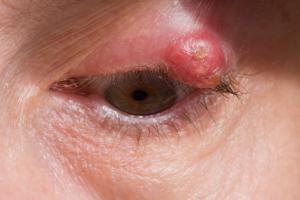
These cysts:
- vary in size, from barely visible to the size of a grape
- usually take weeks to develop
- are not usually painful, but can become red and painful if infected
- can come and go by themselves, although they may take a few months to get better
You can help them heal by holding a clean flannel warmed in hot water to the closed eye for five minutes, and repeating this three to four times a day for up to four weeks.
Speak to your GP if you have a cyst that doesn't clear up after a month. They can refer you to have it drained through a small incision (cut).
This is a simple procedure carried out under local anaesthetic (your eye area will be numbed).
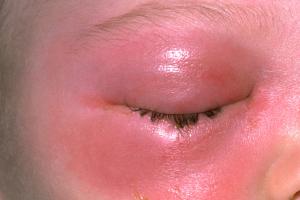
Also see your GP if the cyst becomes infected. You may need to take antibiotics to prevent a deep lid infection (cellulitis).
Another common cause of a swelling on the eyelid is a stye.
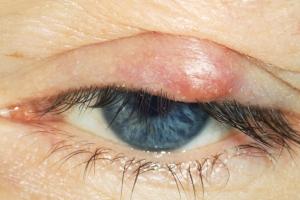
A stye is a minor infection of the base of an eyelash. It usually clears up on its own in a week or two.
Holding a warm flannel to it regularly may help it heal faster.
Be careful not to use water that's too hot, particularly on children.
Sometimes pus may be seen, or may drain from the infection if the stye bursts

Make sure the flannel is not too warm to avoid a scald or burn. Test how warm it is using the skin on the back of your hand.
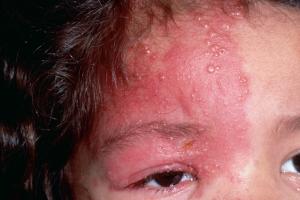
Other causes of lid swelling include an allergic reaction and shingles on the face and eye (usually with a rash). These are less common.
Itchy, flaky or sticky eyelids
Itchy and flaky eyelids are usually caused by an inflamed eyelid edge (blepharitis) or dry eye.
Your eyelids may also stick together and be difficult to open, particularly when you wake up.

These conditions can be irritating, but are rarely serious. You can reduce the irritation by keeping the eyelids clean and using artificial tears if your eyes are dry.
Contact dermatitis is another possible cause of itchy or flaky eyelids.
This is a type of eczema triggered when the skin comes into contact with something you are irritated by or allergic to, such as make-up.
The condition usually clears up after you stop using the substance your skin is reacting to.

Sticky eyelids along with red and watering eyes can be caused by conjunctivitis. This happens when an infection, allergy or irritant causes the front of the eye to become inflamed.
This can get better on its own, although your GP may be able to prescribe medication to treat the underlying cause.
Lumps on or around the eyelids
Lumps can occur on or around the eyelids. Many lumps are simple cysts or styes (see above).
Occasionally a lump can be a sign of a more serious condition such as skin cancer and may need to be removed.
See your GP if you're worried about a lump on or around your eyelids.
Basal cell carcinomas
Most skin cancers are basal cell carcinomas.
These:
- very rarely spread to other parts of the body
- often appear as a red or pink lump containing small blood vessels, although they can be pearly-white or ’waxy’ looking
- sometimes they may bleed
Squamous cell carcinoma
Less commonly, the lump may be a squamous cell carcinoma. This is more serious as there’s a small risk it could spread to other parts of the body.
These usually look like an ulcer with a red base and a scaly and crusted surface. You may also lose eyelashes where the lump is growing.
Melanoma
In rare cases, the lump could be a sign of a very serious type of skin cancer called melanoma. This can spread to other parts of the body and can be dangerous.
A lump is more likely to be melanoma if it's:
- an irregular shape
- dark or changing in colour
- getting a lot bigger over time
Hooded or droopy upper eyelids
As you get older, it's quite common to have excess skin above the upper eyelids that can overhang and block your vision.
If it affects your vision, surgery may be considered to remove the excess skin.
This operation may be considered a cosmetic operation, depending upon the particular circumstances. Many cosmetic operations are not available via the health service. Your GP can refer you for advice if you are having problems.
If the edge of your upper lid droops down over your eye, it's called ptosis. This is usually age-related and develops slowly.
Surgery may be needed if the edge of the lid droops so much your vision is affected.
In rare cases, ptosis isn't related to age and may be caused by serious conditions such as myasthenia gravis or a brain tumour. In these cases, it's likely there would be other symptoms too.
See your GP immediately if:
- ptosis comes on rapidly, over days or weeks
or if
- it's associated with other symptoms, such as a headache, loss of vision or a change in the size of the pupil (the black dot at the centre of the eye)
Lower eyelid that rolls outwards (ectropion)
As you get older, one or both lower eyelids can sometimes droop away from the eye and turn outwards. This is known as an ectropion.
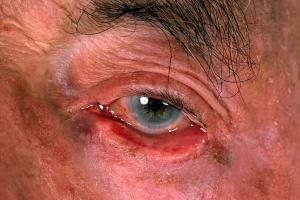
The drooping eyelid can disrupt the normal production of tears. This can cause your eye to become dry, red and irritated.
Treatment may not be needed in mild cases, although drops or ointment may help make your eye more comfortable. Sometimes a minor operation is needed to fix the position of the eyelid.
Eyelids that roll inwards (entropion)
Entropion is where the eyelid rolls inwards. It usually affects the lower lids, but it can also affect the upper lids. Like ectropion, this is often age-related.

Entropion usually causes an uncomfortable watery eye because the lashes irritate the front of the eye (cornea).
If this is mild, using eye drops may be enough to protect the eye and keep you comfortable.
Severe entropion can be painful and cause vision loss by damaging the cornea. Occasionally, a corneal ulcer can form and become infected.
In some cases surgery may be needed. This is if it's posing a risk to the health of your eye or is causing significant discomfort. This is carried out under local anaesthetic.
If you have entropion, you should discuss your treatment options with your GP. Speak with your GP immediately if your eye becomes painful and red and your vision is affected.
Yellow plaques on the eyelids
Flat yellow patches (plaques) over the upper or lower eyelids are called xanthelasma.

Although these plaques are harmless, they are a sign you have high cholesterol. See your GP because you may be at risk of developing cardiovascular disease, such as heart attacks and strokes.
Making changes to your diet and taking medication may be recommended. This is to reduce your cholesterol level and reduce your risk of serious problems in the future. These may not improve the plaques.
If you're bothered by the appearance of the plaques, it may be possible for them to be surgically removed or treated with a laser.
This operation may be considered a cosmetic operation, depending upon the particular circumstances. Many cosmetic operations are not available via the health service. Your GP can refer you for advice if you are having problems.
Excessive blinking or uncontrollable closure of the eyelids
It's quite common and normal for the eyelid to flicker or twitch occasionally. This is particularly when you're tired.
It's more unusual to have repeated spasms of excessive blinking and involuntary closure of one or both eyes.
This is a type of dystonia. This is a movement disorder that causes muscle spasms and contractions. It is known as blepharospasm. Each spasm can last for a few seconds to a few minutes.
The exact cause of blepharospasm is unknown. The blinking and closure can be triggered by bright light, stress or tiredness.
Severe blepharospasm can be very disabling and embarrassing. In some cases, your GP may consider referring you to a neurologist (a specialist in conditions affecting the brain and nerves) for further investigation.
More useful links
The information on this page has been adapted from original content from the NHS website.
For further information see terms and conditions.